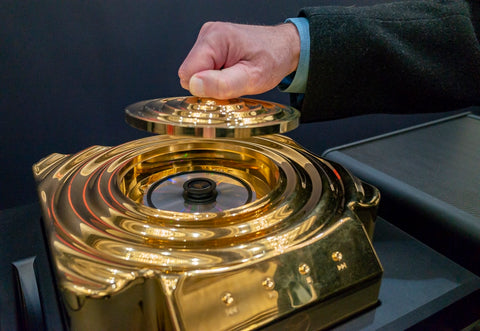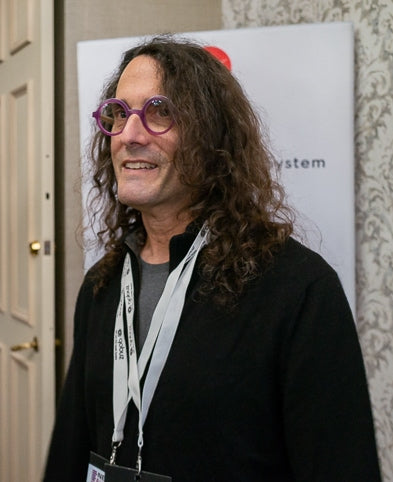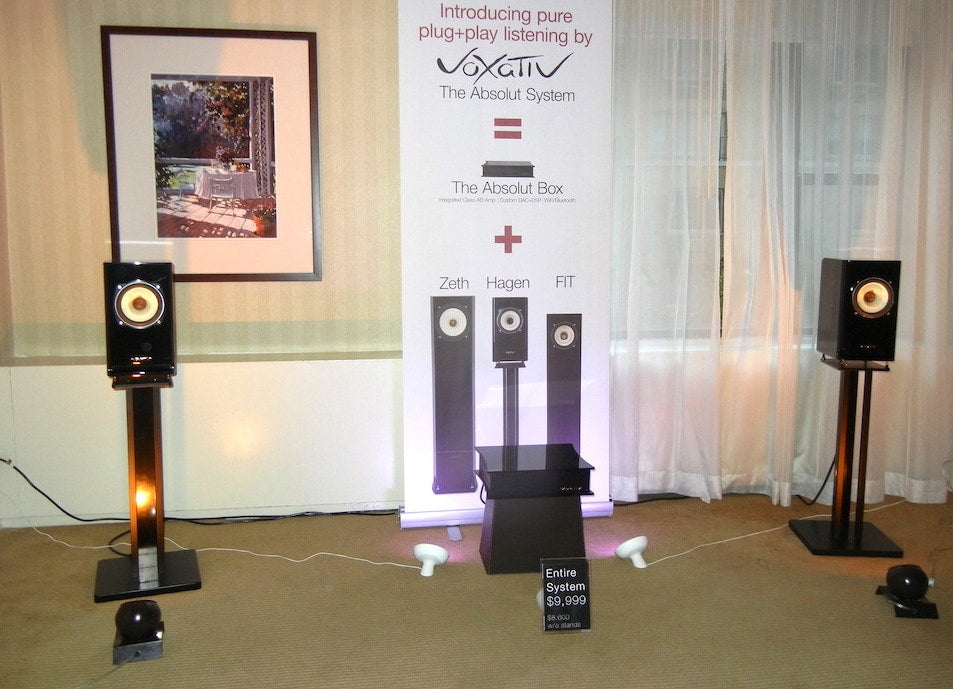Part One of this report appeared in Issue 99. As noted in that installment: I don’t make definitive sonic judgments at shows; there are too many variables, the room being the biggest among them. I didn’t get to have a proper listen in every room (too many people in the room, the system was still being tweaked or other factors). That said, I know what I like, having heard hundreds, maybe more than a thousand exhibit rooms over the years, even if others may have different preferences.
Adirondack Audio/HiFi Loft had a beautifully-styled system with Luxman electronics and turntable and Triangle Acoustics Magellan series loudspeakers, wired with Nordost cable. I’m a sucker for vintage-styled components (I’ve spent more time than I should admit just staring at McIntosh power meters) and this retro-contemporary display was just gorgeous and I thought the sound was just as inviting. Maybe it was the tubes including the now-classic MQ-88uC KT88-based mono amplifiers (though Luxman makes both tubes and solid-state gear), maybe it was the friendly atmosphere, maybe you do hear with your eyes, certainly the good sound was a major part of it but I just had fun in this room.
How does the audio industry bring good sound to a new generation? Andover Audio showed a great example of just how to do it with their Model One Record Player and matching Spinbase Turntable Speaker System, Model One subwoofer and Model One stand/record rack. The omnidirectional speaker system was only a few inches deep yet delivered rich, room-filling sound absolutely worthy of being called high-end – and the turntable didn’t flinch even at higher volumes even though it was resting atop the speaker module.
“How do you do it?” I asked Andover’s James DiPaolo. “Good engineering!” he replied. Although not cheap at $3,600 for the stack as displayed, it sounded better than I would have imagined at first look, and other veteran audiophiles in the room with me agreed. An exceptional solution for someone wanting good sound that fits easily into their living space.

Andover Audio’s equipment stack, which filled the room with sound. Photo courtesy of Frank Schramm.
New Jersey dealer Woodbridge Stereo hosted a no-holds-barred setup that included Martin Logan Neolith loudspeakers, a phalanx of Mark Levinson electronics and MIT cables and power management products. This was a popular room as it was located right next to the show entrance and was large enough to hold dozens of people comfortably. As you can imagine, this was large-scale sound. I’m going to refrain from commenting about said sound (you know-it-alls can insert the sound of a chicken clucking here) since I was there hours before the show opened and I don’t know if the system was warmed up, and while I was in the room there were some internet connection issues to be sorted out. When I returned at the end of the day the room was closed.
(An aside: anyone who uses WiFi as a source at audio shows knows how challenging if not maddening this can be. At a Rocky Mountain Audio Fest a few years ago exhibitors located in the outdoor tent had to contend with power glitches and re-booting routers multiple times before getting reliable connections – right before the show started.)
Speaking of large-scale setups, none was larger than not one but two gargantuan rooms from ESD Acoustic. In fact they were so big that at first I thought one of the rooms was their complete exhibit – then someone told me there was another adjoining room! The systems themselves were huge, with the immense multiple-horn Dragon loudspeakers and in one room, literal stacks of electronics, partly required because the speakers required multiple amplifiers, preamps and crossovers. The CDT-1B CD transport had a heavy brass lid that was machined in an old-furniture style and the player looked different than any other piece of gear I’d ever seen. One of the systems alone costs well into six figures. As in, start thinking along the lines of half a million. These systems are a completely different concept in music reproduction.

Calling all cars! Be on the lookout for three photographers! FD, Harris Fogel and Frank Schramm in the ESD Acoustic room.
Interestingly, the speakers, including their Panda bookshelf model, (which delivered an impressive amount of volume and presence for its modest size) used field coil compression drivers. (When I put my hand on the tweeter and supertweeter units, they were warm to the touch.) ESD embraces field coil magnets because of their high power and tight control over the driver diaphragms. The horns are made from carbon fiber and the Dragon system has a remarkably high 112 dB sensitivity. (A Klipschorn is specified at 105 dB by comparison.)

Not your typical black box: the ESD CDT-1B CD transport. Photo © Harris Fogel, 2019
I have to hedge about the sound because I only listened to unfamiliar music and mostly because this system was so different than anything else I’ve ever experienced that I would want hours, not minutes, to really get a handle on it. That said, I heard effortless (I mean really, really effortless) dynamics, a huge sense of scale and can definitively say the mighty Dragon could play at insanely, ungodly loud volumes. I’m talking rock concert loud, JBL Vertec-line-arrays-from-a-yard-away loud. At the Friday night after-hours party they cranked up some techno and people in the adjoining rooms, not knowing what to expect, freaked out and came running in, yelling for them to turn it down. Walls were shaking. I think some people were shaking. Hey, audio shows should be fun!

Ultra HD-Audio recordings courtesy of Mark Waldrep and AIX Records. Photo © Harris Fogel, 2019
The Marketplace section featured a smorgasbord of used and new vinyl and hi-res audio from AIX Records, Chesky Records, HD Tracks and Acoustic Sounds. (You want more evidence vinyl is on the ascendance? Chad Kassem told me they completely sold out their $150 Jimi Hendrix Axis: Bold as Love mono box set.) Also present were Dana Cable, Gingko Audio, Robyatt Audio, Mytek Digital Audio and Tweak Studio, who had a table full of, well, system tweaks of every variety. Tweak also had an all-out listening room on another floor with Krell, Burmester, Sota, Stillpoints, Wireworld, T+A and other products.



Try as I might I’ll never have hair as good as David Chesky (Chesky Records, HDtracks). Photo © Harris Fogel, 2019
Marantz and Polk Audio (showcasing their Legend L800 speakers) shared a room, and Marantz also showed in the Value Electronics room along with Technics, Dynaudio, Ortofon and AudioQuest. However, every time I tried to get a good listening spot the room was too crowded to hear the speakers properly. The fact that the room was crowded was undoubtedly good for the exhibitors. The PureAudioProject room, which also included Pass Labs amps, Luminous Audio Technology cables and a VPI turntable, was also too crowded for me to get a proper listen, although I’ve heard these speakers sound good, well, much better than good, at other shows. These speakers embody an interesting concept – they have a modular open-baffle design, and the components, drivers and baffles can be put together to suit the listener’s system and room. Among the components the user can choose are Voxativ, horn, ESS-Heil AMT1 or other main drivers.

The PureAudioProject speakers with Pass Labs amps and other gear.
Affordable high-end was alive and well in the Vanatoo room, where the company showed their Transparent Zero and Transparent One Encore Bluetooth-enabled powered speakers at $359 and $599 per pair respectively. (The speakers can be had as low as $319 and $499 in other finishes.) I got to hear both of these small speakers (the Zero is only 7-1/2 inches high) and was thoroughly impressed by their clarity, tonal balance and spaciousness. When paired with a subwoofer, they delivered full-range sound that easily filled the demo room.

Small size, surprisingly big sound was heard from these Vanatoo speakers. Photo © Harris Fogel, 2019
Voxativ showed its Absolut Hagen complete system that included speakers and electronics, including an all-in-one DAC, streamer and amplifier combination. I only got a brief impression but what I heard was clear and detailed if not the last word in low-frequency impact. My intuition is that this system would shine in a home environment rather than a hotel room.

The all-in-one Voxativ system from Germany.
The Kubotek/Haniwa room had personal meaning for me, as well as some interesting sonic stuff going on. A few years ago Haniwa principal Dr. Tetsuo Kubo purchased many of Harry Pearson’s records. For those who may not know, Harry was the founder of The Absolute Sound and I worked for him full time for about seven years. He passed away in 2014. Dr. Kubo had a number of these records in his booth. The very same records that I had held in my hands, placed on the turntable and listened to with Harry countless times.
In fact, when I was in the booth he played “Goodnight Irene” from The Weavers Reunion at Carnegie Hall 1963 album, one of Harry’s top references. The same copy I hadn’t heard in more than 20 years. When I heard the ticks and pops that are unique to that copy of that album, not only did I remember them, I was transported back in time. I practically turned around to look at Harry sitting next to me. It was emotionally overwhelming.

Kubotek/Haniwa’s Yoko Nakamoto, Robert Bean and Dr. Tetsuo Kubo. Kampai! Photo © Harris Fogel, 2019
The Haniwa room featured a complete system – literally from the cartridge to the speakers. It utilizes proprietary Truesound technology, in which the signal from the turntable is digitized and processed via the integrated amplifier with the goal of correcting time, phase and frequency response in real time. Sounds heretical if you’re an analog person – but there was something special going on in this system. Also, the phono stage uses an unconventional current loop design.
Although I was unfamiliar with every single component, the reproduction of instruments and vocals had a sense of reality that shone through. I haven’t figured it out yet. If what the manufacturer claims is true, then it does have something to do with correcting the attributes they claim as the system’s advantages. And this was through the small HSP01 speakers, which looked like little horns mounted on stands, yet filled the room with impressive bass and volume. In playing back the Mercury Living Presence LP of The Firebird, the orchestra, though scaled down in audible size (which inevitably diminished the “you are there” illusion to a degree) had a realism of instrumental texture and dynamics that resulted in everyone in the room listening all the way through the side – and applauding at the end.















0 comments